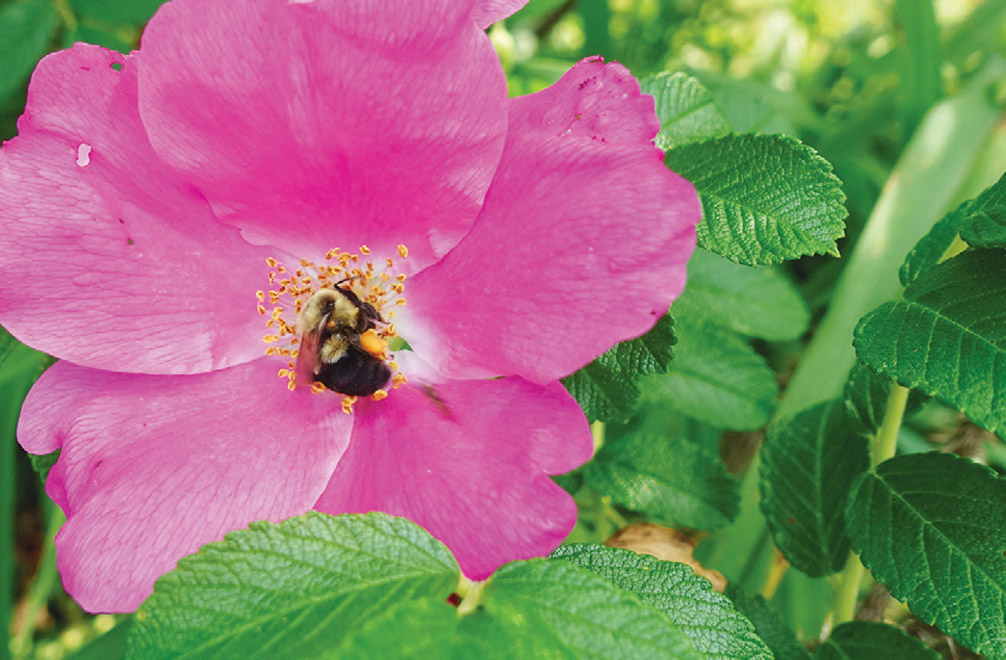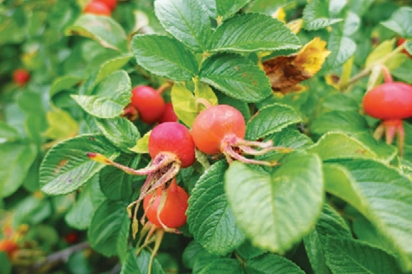Eating Wild: Raise a Toast to the Beach Rose
As an avid forager and a lover of uncommon ingredients, there are few things I enjoy more than discovering that a delicious and useful plant has been right under my nose (or feet) for years. Wild grapes and milkweed. Cattails and dandelions. Cranberries and sumac. Edible plants drape above us, weave around us, and blanket the ground below us as we move mostly unaware through their space.
Such is the case with one of our most prolific neighbors here on Cape Cod — Rosa rugosa, or beach rose. Lining sand-swept roads and paths and forming dense hedges of bright green, it would be difficult to travel far around the Cape without spying this common plant’s leathery leaves and pink or white flowers. Far less showy than the cultivated flowers that often come to mind when we think of the word rose, Rosa rugosa’s appearance fits its most common name, beach rose, perfectly. Unlike the ruffled, multi-layered roses that frequent florist shops, the beach rose’s hardy flowers, which typically have a single layer of tough and slightly wrinkled petals, look ready for inclement weather. This is a rugged rose that can thrive in the cool, windy conditions and sandy soil of our Northeastern shoreline.
Beach roses, of course, have prickly stems and that strong, sweet rose fragrance we are all so familiar with. Their characteristic floral essence is rose petals’ biggest selling point when used as an ingredient. But while the beach rose’s petals are perhaps my favorite harvestable part of this prolific plant, it is far from where the culinary possibilities end.
Whenever I am introduced to a new edible wild plant, the first question I ask (after ensuring that it can be harvested sustainably) is, “Can I fritter this, steep it as tea, or mix it with booze?” If I can do at least one of those, then I consider it a win. In the case of beach roses, the answer to all three questions is yes, and that yes applies to at least three harvestable parts of the plant — the leaves, the petals, and the end-of-season fruit of the rose: the rosehip.
While Rosa rugosa is not necessarily a rose you’d see in a tea-party floral arrangement, tea is the easiest way to take advantage of the plant. Each edible part of the beach rose can be used to make an excellent warming brew. Beach rose leaves can be steeped either fresh or dried. Rose petals can similarly be steeped dried or fresh, either on their own or (my preference) as part of a colorful herbal mixture by pairing the rose’s lovely pink petals with the vibrant yellow-orange ones of the calendula flower.
Rosehips are perhaps the most visually interesting part of the plant and are also the part that packs the biggest nutritional punch since the fruit is loaded with vitamin C. Appearing much like bright red cherry tomatoes, rosehips have dried, squiggly ends that have been described by my young students as octopus legs. While rosehips are not an ingredient one would eat raw, and require a bit of processing to use, the effort is worth it. Simply cut off both ends, slice the fruit open, and remove the seedy, hairy inside. The halved “shells” can be used fresh to make tea or can be dried in a dehydrator and stored for later use. If your rose hips are covered in tiny hairs you can strain the tea through cheesecloth before serving, though I often find that this isn’t necessary when using dried rosehips.
Beach rose’s petals and hips can also be used to make jelly, and the fresh rose petals are a lovely addition to cookies, pastries, and (like most of my favorite ingredients) make a great fritter. My most frequent go-to use for Rosa rugosa is to harvest a few flowers for a fragrant simple syrup that can be used in drinks and desserts. As a mixed-drink ingredient, I love pairing rose petal syrup with seltzer, some muddled fresh herbs like thyme or lemon balm, and a squeeze of lime. Throw in some gin for a cocktail that is sure to impress at any summertime garden party or beach gathering.
As always when foraging ethically, it is important to examine a plant’s abundance in a space and its role in the surrounding ecosystem. Luckily, unlike so many other plants whose habitats are disappearing and that overharvesting has left in dire straits, the wild rose is one we can comfortably pick without much worry. Though the plant certainly grows wild at this point, it was originally an introduced species and is generally considered invasive. Its hardy nature means it doesn’t need our help to spread. Just make sure to leave plenty of the flowers and rosehips you find for your neighborhood pollinators and hungry woodland creatures.
The next time you go for a seaside stroll, keep your eyes (and your nose) open for a burst of pink and that familiar rosy scent, and take stock of this bountiful edible plant that is an often overlooked but endlessly useful part of our surrounding Cape Cod landscape.
NOTE: Always consult with experts and refer to field guides for 100% positive plant identification before consuming any wild plant. Pick wild plants from areas unlikely to be treated with harmful chemicals, and do not pick plants from protected spaces. As with any new food, integrate wild plants into your diet in small quantities to gauge any dietary sensitivities, and consult with a doctor if you have any questions or concerns about specific health issues or medication interactions.






